"I don’t see the city anymore. All I see are its dark corners."Karen Page, Daredevil S1E2
I took the last Friday of the school holiday off, and took the youngster out for a trip to Arcade Club in Leeds. It’s a bit of a run for us (the opposite side of the city) but it turned out to be a fun afternoon. Arcade Club has three floors packed with a huge number of arcade consoles from the 1970s onwards. The ground floor has machines from the 1990s onwards, including rhythm games, pin ball and the classics like Daytona and Sega Rally. The mezzanine floor is filled with all the classic coin-ops I remember from the 1980s, and the top floor has fighting games, VR, consoles, and more Japanese style sit at consoles.
You play a flat entrance fee, and all the games are on free vend. We were hit with a wave of sound as we came in; the ground floor is a storm of noise. The staff were friendly, and we also had a break at the cafe, which wasn’t overpriced at all. There is a reasonable bar selection, probably aimed at catering for the crowd after the post 6pm ‘no kids’ cut off.
We tried a couple of games on the ground floor; Ridge Racer, Sega Rally and a flying game called Afterburner, but quickly went upstairs. The youngster wanted to try some of the classics. Immediately after we got upstairs he was in the Atari Star Wars pod. This was the classic wire-frame Death Star attack (which he’d played as a kid on my old iPad). He loved it.
We then went around and played loads of machines.
 |
| Screen shot of Eternal Lies on iPad |
 |
| The doughnut update for March 24 |
March 2024 was a slow month, as I had to cancel a session for Achtung! Cthulhu at short notice as I couldn't get away early from a work event in Bury St Edmunds. I had to be realistic and accept that I wasn't going to be back in Yorkshire for an 8pm kick off if I didn't get away until 5.30pm. Even if I had, I suspect tiredness would have marred the game. We only got a single session in this month. However, I've had two lovely sessions of Eternal Lies (Trail of Cthulhu), so these two games are tied for session count this year.
I'm seriously toying with the idea of offering a one-shot of Old Gods of Appalachia as I've just read one of the recent scenarios from Monte Cook Games that looks like a good introduction, and was prepared for convention use so it has all the characters available.
I'm also starting down a Dune RPG rabbit hole, which is probably good as the books have been building up in my to-read pile. That's thanks to the Fall of the Imperium sourcebook.
I should be doing preparation for North Star in May. Dr Mitch and I are doing a sequel to Echoes from last year with Star Trek Adventures and I need to re-read Across a Thousand Dead Worlds to get my head around what scenario I will run.
Longer term, I need to start to work my way through The Stealer of Souls and The Black Sword in preparation for hacking them to Tripod for Longcon later in the year. This will also involve a re-read of the Elric books for the first time in years. I'm not certain if I will re-read the books in the lovely compilations I've picked up in hardcover or perhaps using the Kindle versions to increase my book count for the year. I have both, so it will be interesting to see where that ends up.
3 April 2024
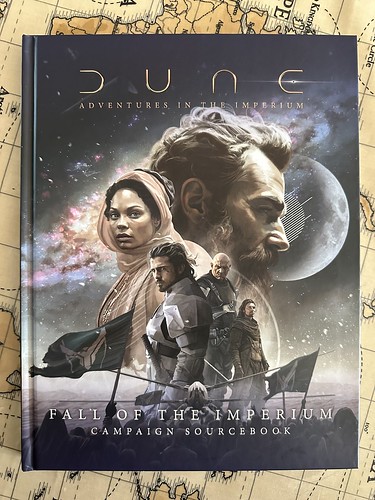 |
| The Fall of the Imperium |
TL;DR: Fall of the Imperium is an epic campaign that will see the characters rubbing shoulders with the key movers and shakers in the Imperium. It doesn't shy away from the hard choices and horror that the Atreides victory brings with it. Choices have consequences, and the fate of billions will be in their hands. The scenarios are sufficiently open to allow them to be adjusted based on the decisions of the players. The writing is strong, and the book is beautifully illustrated. It is let down by poor proofreading, with too many errors that should have been trapped before production marring what would otherwise be a stellar product.
 |
| Pages read in March 2024 |
March 2024 was a good month for reading, with 11 books and 2715 pages read. Year-to-date, that puts me at 27 books and 7632 pages, or as the target tracker says, "Brilliant, you are ahead by 14 books". I set myself a target of a book a week (something I've done for a long time), but do expect to beat that based on past years.
I read 3 roleplaying games, 1 graphic-novel, and completed 1 non-fiction autobiography. The balance were a range of novels.
The roleplaying games were Old Gods of Appalachia (link to review), Comrades, and Heart. I think I will be running the first two of those at some point. Comrades is a Powered-by-the-Apocalypse engined game of revolution, in which the players take the role of the revolutionaries against an oppressive state. Heart is a fun game, built off the same setting as the Spire roleplaying game, but I came to the conclusion that it just wasn't going to get to the table as there were multiple other fantasty games that I wanted to play before it.
The graphic novel was the second volume of the 2039 Blade Runner spin off, which is providing much of the back-story fill in that the roleplaying game really doesn't. That's not to say that the game isn't great, just that it's a little lighter in content than I expected.
The autobiography was Rory Stewart's Politics on the Edge, which talks about his time as an MP. In some ways, its pretty depressing as it really explains how the UK parliamentary system works and how bad the fast rotation of ministers through departmental roles gives a huge challenge to any of the departments that they are to maintain consistency and focus. I already understood Stewart's opinion of Boris Johnson, but this also expands out on how he came to the view that he regularly expresses on The Rest is Politics. Speaking of which, I had to speed up the narration (I was listening to this on Audible during work trips) as Stewart reads his book at a much slower pace than he talks in the podcast, and it was frustrating. I usually listen to podcasts and audiobooks at 1.1x speed, but had to go higher. Definitely worth a read, but his colleague Alastair Campbell's last book (But What Can I Do?) is a more hopeful companion.
The novels included the third book in the Prefect Dreyfus sequence by Alastair Reynolds, Machine Vendetta. This does draw upon elements of the first two books, but I didn't feel a need to re-read them despite it being quite a while since I read either. I enjoyed the story, especially as it shows more of the Glitter Band (a democratic anarchic collective of space stations and asteroids) first mentioned in Revelation Space. The book comes to a satisfying end and reminded me why Reynolds has remained one of my favourite authors.
I finally got to Aliette de Bodard's excellent A Fire Born of Exile, a story set in the Xuya universe. It's a love story, a revenge story, and a story of unrest and repression. I enjoyed it a lot; there's a beauty to the author's writing which draws me through.
Speaking of that, I feel very much the same about the two Emily St. John Mandel books I read, The Glass Hotel and Sea of Tranquility. The former is more traditional, following the life curves of two half-siblings, Paul and Vincent, against the backdrop of a Ponzi scheme. I loved the writing style the story drew me through. Sea of Tranquility is literary SF; it takes a science-fiction concept and uses it softly, exploring time travel. Initially, the connections between the stories aren't obvious, but as the story builds they become apparent. There's also a link back to The Glass Hotel, and for a moment I wondered if Vincent would escape her fate, but it was a delightful easter-egg. I suspect it made me enjoy the book more than I would if I hadn't read the first book immediately before.
I also completed Len Deighton's London Match (the first of the three trilogies about Bernard Samson). I really enjoyed how it played out, but decided to change gear for a bit before I read the next three books. Finally, I read the latest Kevin Wignall, The First Death of Winter, which was a slight change of gear from his normal novels. If anything, if felt more like an Agatha Christie story. Matt, the night supervisor of a Swiss Tourist hotel in the mountains, faces the arrival of a group of teenagers and teachers out of season, when the mountain is closed for bad weather and the hotel is also not open. Soon after they arrive, one of the kids is murdered, and Matt is forced to do the initial investigation for the police as they cannot access the hotel as the cable car cannot run safely in the storm. However, he also has a secret from his past that he doesn't want to come out. It was a fun yarn and avoided being predictable.
Overall, a good month of reading.
1 April 2024
While Paul Atreides is certainly more pleasant and decent than Vladimir Harkonnen, neither of them are good guys nor bad guys. While Vladimir is selfish, greedy, and hungry for power, Paul still starts a brutal and bloody religious war. Both are the leaders of noble Houses who profit to an extortionate level from the work of their population.
While the people of Caladan live far more pleasant lives than those of the people of Giedi Prime, none live even close to the same luxury as the nobility who rule them.
Throughout this campaign, the player characters must decide who to side with, as their peers will judge them for it. But make no mistake: there are no clearly correct moral choices. There is darkness and light everywhere you look, and the player characters will have to develop their moral compass and decide on which path it leads to.
I love that the Dune roleplaying isn’t afraid to grapple with the moral ambiguity of the protagonist unleashing a holy war to have his revenge on those that tried to wipe his family out.
I also love that the sequel to the first book isn’t afraid to start exploring what that act does to Paul.
The quote is from the new Fall of the Imperium sourcebook which looks fantastic on an initial skim.
25 March 2024
Update 2 April 2024: I’ve now reviewed the book here on the blog.
 |
| The Thing Whose Name Sounds Like Horned Head But Is Not dominates the front cover of the book. |
_logo.jpg) |
| Daredevil |
I started re-watching the first series of Daredevil recently, having not seen it properly since it screened in 2015. It has reaffirmed that this is the best Marvel TV done in recent times. I'm five episodes in, and what strikes me is how adult and direct this is. The violence is brutal, nasty and visceral, and you really feel the struggle in the combat sequences. Hell's Kitchen feels like a real location, with real people, which makes the stakes that the conflict with organised crime raises all the more effective.
In the first two episodes the show establishes itself and the characters and then doesn't deviate. It's very much character-led. I intend to work my way back through the various related series that first aired on Netflix, especially now that they've returned to the Marvel fold and are officially part of the MCU. That said, the tone is much darker and more gritty, which is why I love it.
In gaming, my love of these series manifests itself in my love of Son of Oak Studio's City of Mist roleplaying game which can build a similar feel with ease. It's no surprise that this is a game I've run repeatedly at conventions.
16 March 2024
 |
| Books read year to date - 18 Pages read - 5229 |
I'm writing this three days into March so the numbers are slightly inflated as I finished two books at the very start of the month. Both fiction and non-fiction reading was influenced by the game of Berlin 87, as I really wanted to get a feel of Berlin's geography, culture and locations in my head before Revelation.
I opened the year with two books by Silvia Moreno-Garcia; Silver Nitrate and The Lover. Both were great fun, and I need to read more by her as I previously enjoyed Mexican Gothic.
Sara DiVello's Broadway Butterfly was an interesting and gripping exploration of a murder case in New York in the 1920s.
I then returned to some books I've probably not read in four decades - Len Deighton's murky and delightful Game, Set and Match trilogy (Berlin Game, Mexico Set, London Match). I loved these when they first came out (and enjoyed the banished TV version). I was reading them for the 80s ambience for the Berlin 87 hack of Cartel that I was running, but I'm going to have a short break away from them and read the next trilogy as well.
If I had to pick a favourite, it would be Silver Nitrate, but only by a whisker.
David McCormack's Berlin Cold War 1945-1989 Companion was interesting but felt like it lacked Berlin as a character. Lots about the DDR but the city had a cameo.
Andrew Long's Secrets of the the Cold War was excellent, and gave me lots of ideas to draw on for my game at Revelation.
The Divided Berlin, 1945-1990 - Historical Guidebook by Oliver Boyn was the most useful reference I consulted for my game of Berlin'87. It really gave a feel for the city and the way things were.
Helen Czerski's The Blue Machine - how the ocean works was delightful, and probably my overall favourite book of the last two months. A clear exploration of how the ocean works and how we are impacting it, to our own peril. Fantastic and recommended.
Comrades: A revolutionary RPG - this is a Powered by the Apocalypse game built to explore revolutions. I'm very tempted to give it a roll-out as it looks excellent.
Dragonbane Core Rules and Dragonbane Bestiary have been covered elsewhere, as has Shadowdark and Orbital 2100. I finally read Cartel, which was excellent. I've chased the shadows of the delayed kickstarter away.
I also read Across a Thousand Dead Worlds - very pretty and a slick game that has echoes of Pohl's Gateway. I'll be running this at North Star. Along with that, I read Under Ashen Skies, which is a horror based single player RPG from the same publisher. I do like it but I'm not certain it will get to the table.
I continue to grind through Old Gods of Appalachia - it's good but something isn't quite landing for me at the moment.
Of the roleplaying games, Cartel was my favourite.
3 March 2024
 |
| The doughnut returns |
The end of February brought an interesting mix, thanks to Revelation. I have a balance between face-to-face and online games for the first time that I remember.
The most played game is Achtung! Cthulhu, where we continue with the Shadows of Atlantis campaign. We've lost a few sessions this year because of technology and schedules, but we're two parts into the campaign and about to head into Egypt. The second part, Rome, had the game really let its hair down, especially once Graham got hold of a MG42. The only thing I need to resolve with this game is notes. As I'm running fortnightly, if we miss a session then it means that there's a lot to remember. Initially, the players were doing this but I think I may have to do some pertinent bullet points at the end of each part as the player journal has fallen by the wayside.
The biggest challenge we're all facing is 2d20 bleed, as the slight variances in the game engines between genres comes into play and causes confusion and scrambling for the rulebook. I would like to get this weekly if I could, but two of the other players have games on the alternative weeks.
After that, Eternal Lies for Trail of Cthulhu continues. We're around three years into the campaign, and have reverted back to a GM and duo of players after Nigel had to drop out for medical reasons. This means that it has become increasingly tense and we've come close to death as we explore the Malta leg. The sessions have tipped a little more towards pulp rather than purist noir, mainly as we've ended up having to push our luck to resolve things. The possibility of character death has become much more real.
The rest of the games played and run were at Revelation, which I've covered elsewhere.
I did try to get a game of Orbital 2100 off the ground over Christmas, but scheduling sabotaged us.
3 March 2024
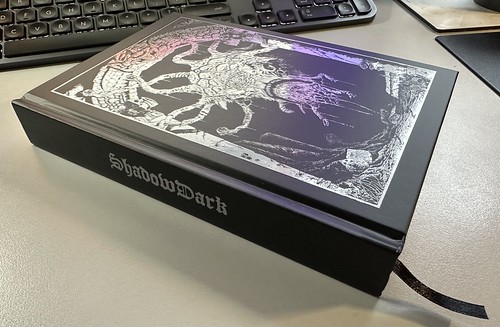 |
| Shadowdark. Lurking on my desk. |
TL;DR: Shadowdark takes elements of the post D&D 3e game engine, building a delightfully light & coherent take on the original D&D games, in a similar vein to the Black Hack. It is very well done, and emulates the style of play strongly, stripping everything back and building it up again. OSR compatible modules should be a breeze to run on the fly. I like what I see, and I'd like to try it out.
 |
| Comparing the size of Shadowdark and Old-School Essentials |
5957 damage, 5 kills, 920 assistance, 460 blocked, 1651XP
#wotb #wotblitz
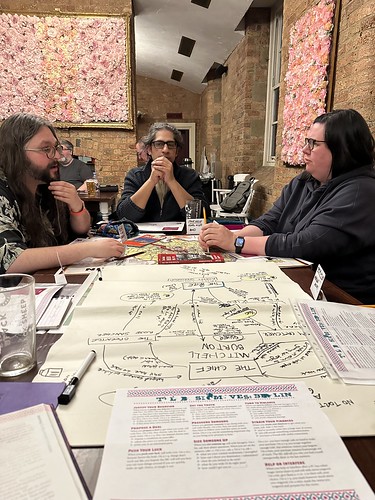 |
| A tense moment at Revelation, as the Chief of Berlin Station discusses the fate of the Mole with the CIA Operator in Magpie Games' official hack of their Cartel game to Cold War Berlin. |
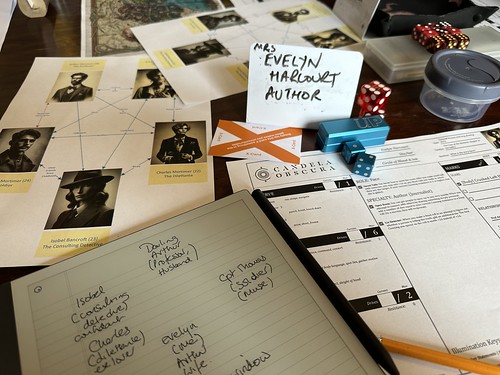 |
| Candela Obscura - Slot 1 |
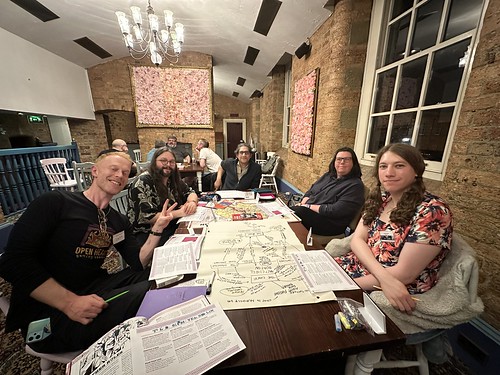 |
| The Berlin'87 players - thanks for a great game |
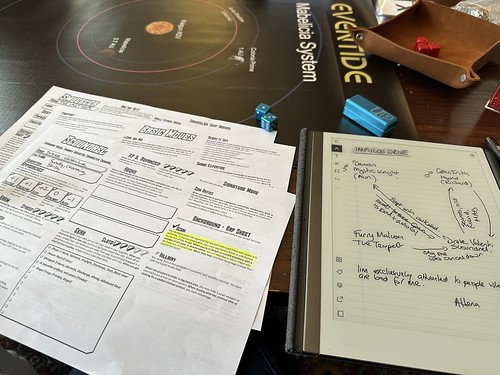 |
| Impulse Drive with Table bling |
 |
| Jamie's cake! |
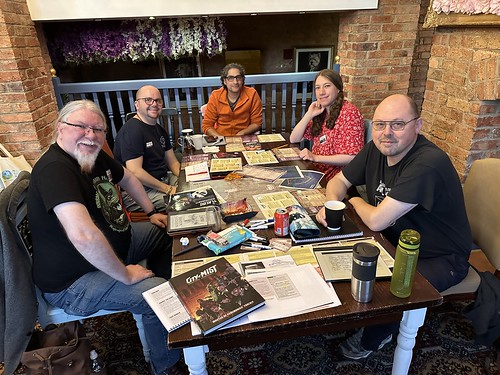 |
| The second game of City of Mist |
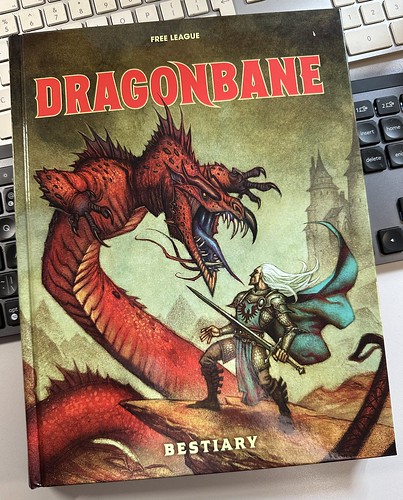 |
| The Dragonbane Bestiary |
This will be a short one, as this is a simple book. The Dragonbane Bestiary is a 148-page full colour hardback illustrated gorgeously by David Brasgalla. The artwork is in a similar style to the cover and other material provided by Johan Egerkrans for the core rules. This is the expanded monster manual for the Dragonbane roleplaying game; there is some overlap between the two books, but the entries in the Bestiary are significantly expanded. In addition, the book provides the information to make some of the kin usable as player characters. Goblins, Hobgoblins, Ogres, Orcs, Cat People, Frog People, Karkions, Lizard People and Satyrs are now available to join your adventuring party!
The conceit of the book is that it is the work of one Theodora Sneezewort, a halfling scholar who may have been lost in crevice while trying to enter the lair of Arknarath, the Father of all Dragons. The entries reflect this, starting with Theodora's commentary on the creature or kin, before being followed with an example random encounter and then a more extended adventure seed. There's an evocative illustration, and then the stat blocks plus details of the ability the kin would get if used by a player.
The general categories used are Nightkin (Goblins, Orcs etc), Rare Kin (the likes of Cat People and Satyrs), Insectoids, Beasts, Trolls, Giants, Undead, Dragons and Demons. Whereas the core book has one Demon example, the Bestiary gives six different types. Similarly, there are five different dragon examples (differing ages and the wingless Lindworm). Trolls and Giant have similarly expanded entries with several different flavours.
This is an unpretentious book; it delivers exactly what you'd expect, a large selection of potential allies and opponents. It isn't essential, but if you plan to run Dragonbane it will add some great options and flexibility to your game.
Recommended.
25 February 2024
TL;DR: Overall, I’m impressed with Dragonbane. It’s mechanically light enough to fade away but provide lots of fun. The boxed set promised mayhem and mirth, and this polished, well written, simple and beautifully illustrated rulebook gives you the tools for a lot of fun time adventuring. It reminds me of the old-school, but it takes the BRP-heritage and hones it to a sharp and effective modern point.